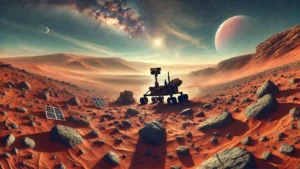Space Missions have long captured human imagination, symbolizing our quest to understand the universe and our place in it. From the early missions that sent the first satellites into Earth’s orbit to the ambitious plans for Crewed Mars exploration, Space Missions have evolved to be among the most complex and advanced projects humanity has ever undertaken. Today, Space Missions not only fuel scientific discovery but also inspire technological advancements that benefit us on Earth. Through these missions, we aim to explore the cosmos, protect our planet, and potentially establish a human presence on other celestial bodies.
Evolution of Space Missions:
Space Missions have come a long way since the first artificial satellite, Sputnik, was launched by the Soviet Union in 1957. This event marked the dawn of the space age, initiating an era of rapid development in space technology and exploration. Shortly after, Yuri Gagarin became the first human in space in 1961, setting a major milestone for Crewed Space Missions. NASA’s Apollo missions soon followed, culminating in the historic Apollo 11 landing on the Moon in 1969, where Neil Armstrong and Buzz Aldrin set foot on lunar soil.
Also Read: The Vision for a Colony in Mars
As technology advanced, so did the scope of Space Missions. Today’s missions are no longer limited to Earth’s orbit; they reach deep into our solar system and beyond. From the Voyager probes exploring interstellar space to the Mars rovers that study the Red Planet’s surface, each mission expands our understanding and raises new questions about the universe.
Role of Technology in Space Missions:
Technology is the backbone of successful Space Missions, providing the tools and innovations needed to survive in extreme environments. Modern spacecraft rely on cutting-edge navigation, propulsion systems, and communication technology, enabling them to travel vast distances and relay data back to Earth. Artificial intelligence (AI) and robotics play crucial roles, particularly in unmanned missions, by performing tasks autonomously in challenging conditions.
Moreover, advancements in material science have made spacecraft more durable and resilient. For instance, heat-resistant materials protect reentry vehicles from extreme temperatures, while lightweight, strong composites reduce the mass of spacecraft, saving fuel and increasing payload capacity. Technological progress continues to push the boundaries of what’s possible in space exploration.
Types of Space Missions:
Space Missions can be broadly categorized based on their purpose and scope:
Unmanned Space Missions: These missions involve robotic spacecraft designed to explore celestial bodies without human presence. Examples include the Voyager probes, Mars rovers, and satellites in Earth’s orbit.
- Crewed Space Missions: Human spaceflight missions allow astronauts to perform scientific experiments, repair satellites, and test new technologies in space. The International Space Station (ISS) serves as a key platform for such missions, allowing for extended human presence in low Earth orbit.
Interplanetary and Beyond: Some missions venture to distant planets, moons, and even beyond our solar system. Missions like New Horizons, which flew by Pluto, and the Voyager probes, now in interstellar space, represent humanity’s reach into the broader galaxy.
Notable Space Agencies Leading Space Missions:
Several space agencies and private organizations are at the forefront of Space Missions. Here’s a look at some of the key players:
- NASA (National Aeronautics and Space Administration): NASA, the U.S. space agency, is known for its groundbreaking missions, including the Apollo moon landings, Mars rovers, and the Hubble Space Telescope.
- ESA (European Space Agency): ESA collaborates with various countries on missions like the Rosetta probe, which landed on a comet, and ExoMars, which aims to explore Mars for signs of life.
- Roscosmos: Russia’s space agency has a rich history in space exploration, including launching the first satellite and human into space. It remains a major player in human spaceflight and satellite technology.
- ISRO (Indian Space Research Organisation): ISRO has made significant contributions with low-cost missions like the Mars Orbiter Mission (Mangalyaan), which showcased India’s growing expertise in space technology.
Private Space Entities: Companies like SpaceX and Blue Origin are revolutionizing Space Missions with reusable rockets and ambitious plans for Mars colonization and space tourism, increasing accessibility to space.
Mars Missions: A Case Study in Space Exploration
Mars has been a focal point for Space Missions, with numerous agencies striving to unlock its mysteries. NASA’s Mars rovers, such as Spirit, Opportunity, and Perseverance, have provided invaluable insights into the planet’s geology and potential for ancient life. These missions have shown that Mars had water in the past, sparking questions about the planet’s habitability and potential for future human exploration.
ESA’s ExoMars mission and China’s Tianwen-1 also aim to investigate Mars’s atmosphere, soil composition, and search for signs of life. However, Mars missions are incredibly challenging, with only about half of all attempts succeeding. The thin atmosphere, extreme temperatures, and harsh dust storms present unique obstacles for both robotic and future human explorers.
Lunar Missions and their Impact:
Lunar missions have proven vital in understanding not only the Moon but also our own planet. The Apollo program of the 1960s and 1970s set a precedent, inspiring future lunar exploration. Today, countries like the United States, China, and India are renewing their focus on the Moon, with the goal of establishing sustainable exploration.
The Moon’s proximity makes it an ideal location for testing new space technologies. Missions like NASA’s Artemis program aim to return humans to the lunar surface, while China’s Chang’e missions continue to explore the Moon’s far side. These lunar missions contribute significantly to space science, helping us understand the evolution of planets and the solar system.
Space Missions for Planetary Defense
One of the lesser-known but vital purposes of Space Missions is planetary defense. These missions track near-Earth objects (NEOs), such as asteroids, to assess the risk of potential impacts with Earth. NASA’s DART (Double Asteroid Redirection Test) mission, for example, successfully tested asteroid deflection in 2022, showcasing our ability to protect the planet from hazardous space objects.
Programs like NASA’s Planetary Defense Coordination Office (PDCO) continuously monitor NEOs, and Space Missions help refine their trajectories. As our tracking capabilities improve, we’re better prepared to avert threats from space that could cause significant harm to life on Earth.
International Collaboration in Space Missions
The nature of space exploration makes international collaboration essential. Projects like the International Space Station (ISS) are excellent examples of global partnership, with NASA, Roscosmos, ESA, JAXA (Japan Aerospace Exploration Agency), and CSA (Canadian Space Agency) working together. This cooperation not only shares costs but also pools expertise, leading to successful missions.
Collaborations extend to scientific exchanges and joint missions, such as ESA and NASA’s joint Mars Sample Return mission. Such teamwork enables more comprehensive Space Missions, reflecting a shared commitment to expanding humanity’s understanding of the universe.

Space Missions and Environmental Monitoring:
Many Space Missions are dedicated to monitoring Earth’s environment. Satellites in space track critical data on climate change, deforestation, pollution, and natural disasters. Missions like the Copernicus program by ESA and NOAA’s weather satellites provide valuable insights into our planet’s health.
These environmental missions help predict weather patterns, track natural disasters, and monitor the effects of climate change. Data from these satellites inform policies and actions to mitigate environmental impacts, making Space Missions vital for Earth’s sustainability.
Challenges and Risks in Space Missions
Space Missions are incredibly complex undertakings, involving significant technical, financial, and human challenges. Each mission requires meticulous planning, advanced technology, and precise execution, but even the best preparations can’t eliminate all risks.
- Technical Challenges: Spacecraft encounter harsh environments in space, including extreme temperatures, intense radiation, and vacuum conditions. Building machines that can withstand these conditions and continue to operate for extended periods is no small feat. Engineers must also account for factors like propulsion, communication delays, and the immense distances involved, which require autonomous systems capable of handling unexpected issues.
- Human Risks in Crewed Missions: For crewed missions, astronaut safety is paramount. Human bodies are not designed for space conditions, and long-duration missions can lead to muscle atrophy, bone density loss, and exposure to harmful radiation. Psychological challenges, such as isolation and confinement, also pose risks. Additionally, spacewalks and reentry to Earth’s atmosphere come with potential life-threatening dangers, emphasizing the need for rigorous training and extensive safety protocols.
Financial Costs: Space Missions are among the most expensive scientific projects. Building, launching, and maintaining spacecraft require significant resources, and any failures can lead to substantial financial loss. Budget constraints often limit mission scopes, making collaboration with other space agencies or private companies critical to distributing costs.
Future of Space Missions: Aiming Beyond Our Solar System
As we look to the future, Space Missions are evolving to take on even more ambitious goals. Beyond our solar system lies a vast and largely unknown universe, and missions like NASA’s James Webb Space Telescope (JWST) aim to explore it, gathering data on distant galaxies, stars, and exoplanets.
- Next-Generation Missions: Future Space Missions, such as the proposed Interstellar Probe by NASA, aim to journey beyond our solar system, exploring the boundaries of the heliosphere and gathering data from interstellar space. These missions involve unique engineering challenges due to the need for energy-efficient propulsion systems capable of reaching unprecedented distances.
Exoplanet Exploration: Many Space Missions now focus on identifying and studying exoplanets—planets outside our solar system that might harbor life. The Transiting Exoplanet Survey Satellite (TESS) and the JWST provide data on planets in habitable zones around distant stars, potentially finding Earth-like worlds. These discoveries could be stepping stones for future exploration, including missions that might send probes to other star systems.
Importance of Sustainable Space Missions:
With the increase in Space Missions, sustainability has become a significant concern. Space debris, often termed “space junk,” poses a serious threat to active satellites, spacecraft, and the International Space Station. Space Missions now need to incorporate sustainability practices to ensure long-term viability.
- Space Debris Management: Space agencies and private companies are developing strategies to manage debris, including removing inactive satellites and designing spacecraft with the ability to deorbit themselves. Companies like SpaceX have begun to incorporate these measures, using satellites that can self-destruct in a controlled manner at the end of their life cycles.
Environmental Sustainability: Beyond managing space debris, missions are also designed to reduce carbon footprints on Earth. Some agencies aim to use green propulsion technology and minimize energy use, addressing the environmental impact of rocket launches. Sustainable practices ensure that future generations can continue to explore space without exacerbating problems in Earth’s orbit.
Economic Impact:
Space Missions have a far-reaching economic impact, benefiting various industries and creating jobs. They drive innovation, boost economic growth, and spur the development of new technologies that often find practical applications on Earth.
- Job Creation and Industry Growth: Space Missions create jobs in engineering, research, manufacturing, and even tourism. As private companies like SpaceX and Blue Origin push the boundaries of commercial spaceflight, the potential for space tourism and other commercial opportunities increases, creating more jobs.
- Technology Transfer: Technologies developed for Space Missions often benefit industries on Earth. For instance, advancements in satellite communication support internet connectivity, GPS, and telemedicine. Other innovations, such as water purification systems and advanced materials, initially developed for space, have found applications in health, agriculture, and infrastructure, proving the tangible benefits of Space Missions on Earth’s economy.
Space Tourism: Space tourism is an emerging sector that’s poised to impact the economy significantly. Companies like Virgin Galactic and SpaceX have launched the first commercial spaceflights, and the prospect of routine space tourism may soon become a reality. This new industry has the potential to make space accessible to civilians and generate substantial economic gains.
Conclusion:
Space Missions continue to captivate and inspire humanity, pushing the limits of what’s possible and expanding our understanding of the cosmos. From tracking Earth’s environmental changes to exploring distant planets, these missions are more than just scientific endeavors—they represent a testament to human curiosity, resilience, and ingenuity. As space agencies and private companies collaborate to achieve unprecedented milestones, the future of space exploration looks bright.
Space Missions will likely play a central role in shaping our future, bringing benefits that extend well beyond scientific knowledge. Whether it’s finding new resources, understanding our universe, or even establishing human colonies on other planets, the possibilities are limitless. As we look to the stars, we are reminded of our shared destiny, bound by a collective desire to explore, learn, and reach beyond our horizons.
FAQs
1. Why are space missions so expensive?
Space Missions involve intricate planning, advanced technology, and substantial infrastructure, all of which require significant funding. The costs include building spacecraft, launching them, and managing them in space. Crewed missions add costs for astronaut training and safety.
2. What are the different types of space missions?
Space Missions are primarily categorized as Crewed or unmanned. Unmanned missions are robotic and explore distant planets and interstellar space, while crewed missions involve human astronauts conducting research, repairing satellites, and testing new technologies in space.
3. How do space missions contribute to environmental monitoring?
Satellite-based Space Missions provide data on Earth’s climate, deforestation, ocean health, and pollution levels. This information helps scientists understand environmental changes and predict weather patterns, which is vital for mitigating natural disasters and developing climate policies.
Also Read: Exploring the Mysteries of the Helix Nebula
4. What challenges do astronauts face in space missions?
Astronauts encounter physical challenges like muscle atrophy, bone density loss, and radiation exposure, as well as psychological challenges from isolation and confinement. Rigorous training, protective technology, and support systems help them cope with these challenges.
5. What role do private companies play in space missions today?
Private companies like SpaceX, Blue Origin, and Virgin Galactic are pioneers in commercializing Space Missions, creating opportunities for space tourism, cargo transport, and reusable rockets. They are making space more accessible and reducing mission costs, boosting overall progress in space exploration.








